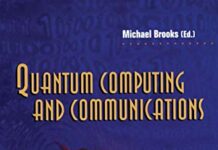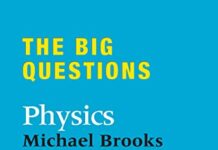
Ebook Info
- Published: 2017
- Number of pages: 240 pages
- Format: PDF
- File Size: 0.81 MB
- Authors: Michael Brooks
Description
A book of science like no other, about a scientist like no other.This is a landmark in science writing. It resurrects from the vaults of neglect the polymath Jerome Cardano, a Milanese of the sixteenth century. Who is he? A gambler and blasphemer, inventor and chancer, plagued by demons and anxieties, astrologer to kings, emperors and popes. This stubborn and unworldly man was the son of a lawyer and a brothel keeper, but also a gifted physician and the unacknowledged discoverer of the mathematical foundations of quantum physics. That is the argument of this charming and intoxicatingly clever book, which is truly original in its style, and in the manner of the modernists embodies in its very form its theories about the world.The Quantum Astrologer’s Handbook is a science book with the panache of a novel, for readers of Carlo Rovelli or Umberto Eco. It is a work of and about genius.
User’s Reviews
Reviews from Amazon users which were colected at the time this book was published on the website:
⭐I liked the idea of mixing discussion of quantum physics with the biography of Cardano. Such an unlikely mix that it was instantly fascinating.
⭐I’m a lover of non-fiction informational books, but I have to say I am pleasantly surprised by this story! It’s such a great blend of story and informational mix science vs. metaphysical Highly recommend!!
⭐It was actually super interesting read with alot of overview about actual mathematical and quantum history. I wonder if I can time travel!
⭐This was a pleasurable read; the author’s magical realist self-assertion in the life of his subject, Jerome Cardano, served well to illustrate the embedded sense of connection across time and space that one who studies people they’ll never meet often experience. His meandering through the ins and outs of Jerome’s life flow neatly through pools of side characters that flesh out the world, reflections on the slow evolution of scientific thought, and intriguing asides into the limits of the fidelity of first hand accounts and historical writing. I learned much picking up how advancements truly are built on the shoulders of predecessors, and got a compelling sense for the intellectual climate and machinations of the Renaissance and Reformation period of Europe.On a separate note, as a half-believer of woo woo who was drawn in by the book’s title, I find the author’s portrayal divination like astrology a bit undercooked, though certainly a step above how most ensconced in the hard sciences would look at it – he did go to the effort of undergoing two astrological readings.One gripe: Not two pages from his paradoxical assertion that “Certainty is always misguided” does he say “there is no pattern or purpose behind the cosmic drama of existence.” Is he certain about this?When woo woo is (largely rightfully) scorned by many skeptically minded folk, the author’s imagining of a relationship across time and space, and his too-rare full-throated admitting of how unresolved relativity and quantum behavior is a century on, is nice to see, so I can’t really fault him for not taking a step further towards the pale.Overall, this book is a quick engaging read that I enjoyed very much.
⭐The authors approach to a biography/book on phyics is unique and extremely refreshing. Excellent read.
⭐This is a very interesting and atypical book in which the biography of the Italian Renaissance polymath Jerome Cardano (1501–1576) is mixed with discussions about quantum mechanics. Michael Brooks, the author of the book, is calling his approach “magical realist non-fiction”. I really liked the magic realism aspect of the book, but I am not going give any details because I do not want to spoil the book. As for the non-fiction aspect, there are two main threads. The first one (and the main reason for which I decided to read this book) is about the life and works of Jerome Cardano. Cardano had an extraordinary life, he was a mathematician, physician, astronomer, inventor, writer, and philosopher, but also an astrologer, and gambler. I remember learning at school about Cardano’s contributions to mathematics, in particular to algebra, and I knew about the Cardan shaft (a mechanical component for transmitting torque and rotation), but I had no idea about his contributions to the probability theory (see Liber de Ludo Aleae/Book on Games of Chance, written around 1564 and published 1663) and imaginary numbers. Probability theory and the imaginary numbers are the connexions to the second thread of the book as they are the “twin pillars of quantum theory”. The second thread of the book not only contains a description of the foundations of quantum mechanics but also descriptions of some of the main interpretation of quantum mechanics (e.g., the Copenhagen interpretation, the many worlds interpretation).Decision: recommended.
⭐Enjoyable read. Nice blend of history, fiction and science presented in an entertaining engaging way. Science content is kept at simple and accessible level
⭐I enjoyed this book very much. It has the same poetic feeling as books by Alan Lightman and Mario Livio. The material is related in a clear and interesting way. Highly recommended
⭐Mixing history and science, this book is a great introduction to quantum mechanics and the life of Gerolamo Cardano, one of those Renaissance geniuses crossing so many different fields, from medicine to mathematics.
⭐Scope. Merging science, historic community involvement, and individual contribution. Most unusual book.
Keywords
Free Download The Quantum Astrologer’s Handbook: a history of the Renaissance mathematics that birthed imaginary numbers, probability, and the new physics of the universe in PDF format
The Quantum Astrologer’s Handbook: a history of the Renaissance mathematics that birthed imaginary numbers, probability, and the new physics of the universe PDF Free Download
Download The Quantum Astrologer’s Handbook: a history of the Renaissance mathematics that birthed imaginary numbers, probability, and the new physics of the universe 2017 PDF Free
The Quantum Astrologer’s Handbook: a history of the Renaissance mathematics that birthed imaginary numbers, probability, and the new physics of the universe 2017 PDF Free Download
Download The Quantum Astrologer’s Handbook: a history of the Renaissance mathematics that birthed imaginary numbers, probability, and the new physics of the universe PDF
Free Download Ebook The Quantum Astrologer’s Handbook: a history of the Renaissance mathematics that birthed imaginary numbers, probability, and the new physics of the universe


